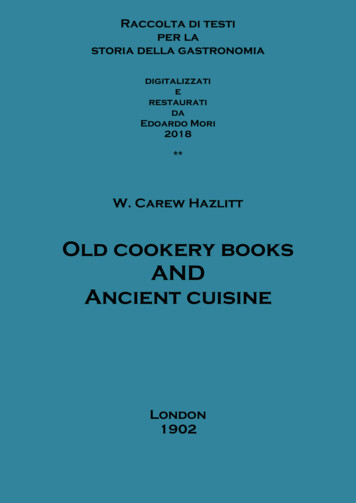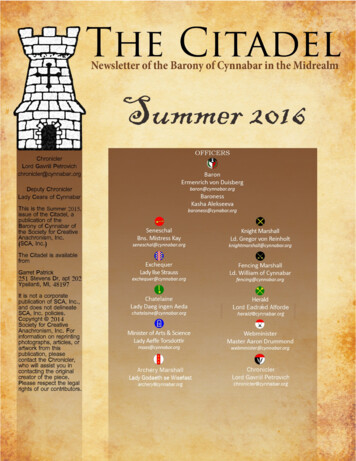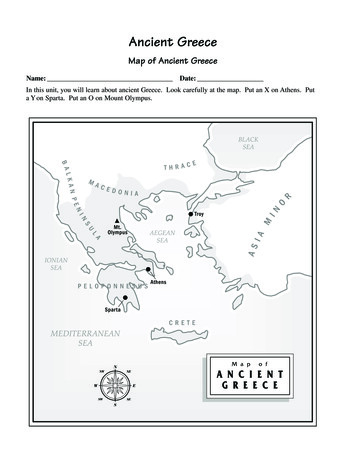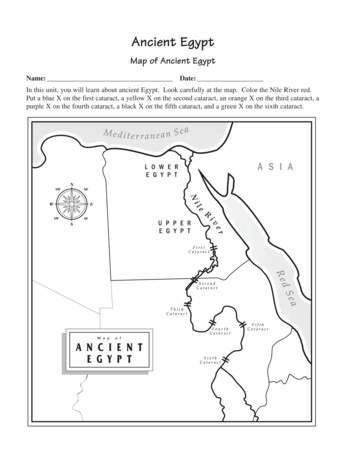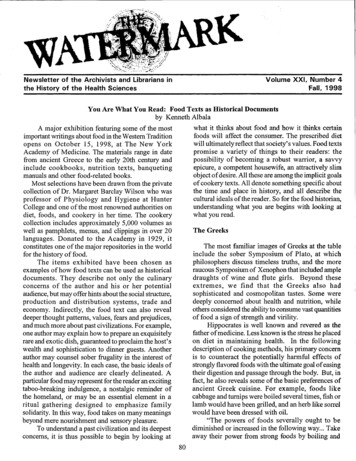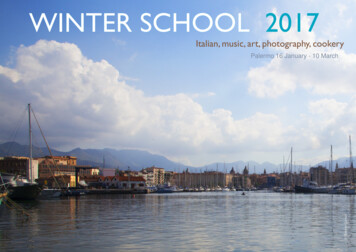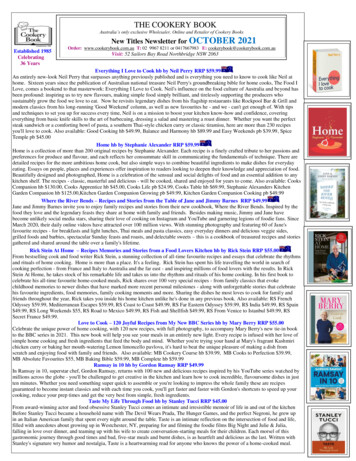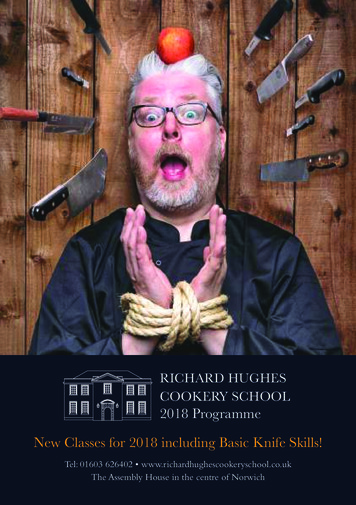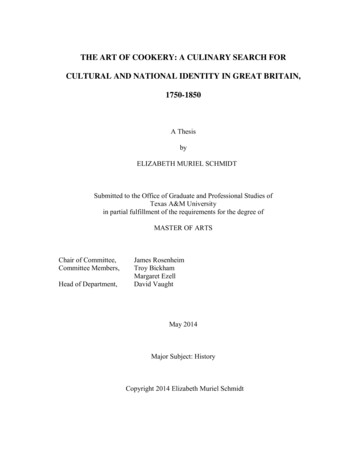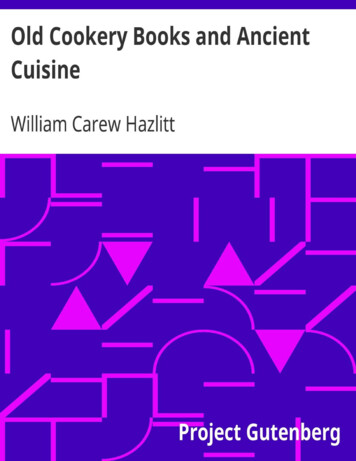
Transcription
The Project Gutenberg eBook, Old Cookery Books and Ancient Cuisine, byWilliam Carew HazlittThis eBook is for the use of anyone anywhere at no cost and withalmost no restrictions whatsoever. You may copy it, give it away orre-use it under the terms of the Project Gutenberg License includedwith this eBook or online at www.gutenberg.netTitle: Old Cookery Books and Ancient CuisineAuthor: William Carew HazlittRelease Date: May 7, 2004 [eBook #12293]Language: EnglishCharacter set encoding: iso-8859-1***START OF THE PROJECT GUTENBERG EBOOK OLD COOKERYBOOKS AND ANCIENT CUISINE***E-text prepared by David Starner, Alicia Williams,and the Project Gutenberg Online Distributed Proofreading Team
The Book-Lover's LibraryEdited byHenry B. Wheatley, F.S.A.
OLD COOKERY BOOKS
ANDANCIENT CUISINE
BYW. CAREW HAZLITTPOPULAR EDITIONLONDON1902THE BOOK-LOVERS LIBRARY was first published in the following styles:No. 1.—Printed on antique paper, in cloth bevelled with rough edges, price 4s.6d.No. 2.—Printed on hand-made paper, in Roxburgh, half morocco, with gilt top:250 only are printed, for sale in England, price 7s. 6d.No. 3.—Large paper edition, on hand-made paper; of which 50 copies only areprinted, and bound in Roxburgh, for sale in England, price 1 1s.There are a few sets left, and can be had on application to the Publisher.
Table of ContentsIntroductoryThe Early Englishman and His FoodRoyal Feasts and Savage PompCookery Books, part 1Cookery Books, part 2, Select Extracts from an Early Recipt-BookCookery Books, part 3Cookery Books, part 4Diet of the Yeoman and the PoorMeats and DrinksThe KitchenMealsEtiquette of the TableIndex
INTRODUCTORYMan has been distinguished from other animals in various ways; but perhapsthere is no particular in which he exhibits so marked a difference from the rest ofcreation—not even in the prehensile faculty resident in his hand—as in theobjection to raw food, meat, and vegetables. He approximates to his inferiorcontemporaries only in the matter of fruit, salads, and oysters, not to mentionwild-duck. He entertains no sympathy with the cannibal, who judges the flavourof his enemy improved by temporary commitment to a subterranean larder; yet,to be sure, he keeps his grouse and his venison till it approaches the condition ofspoon-meat.It naturally ensues, from the absence or scantiness of explicit or systematicinformation connected with the opening stages of such inquiries as the present,that the student is compelled to draw his own inferences from indirect orunwitting allusion; but so long as conjecture and hypothesis are not too freelyindulged, this class of evidence is, as a rule, tolerably trustworthy, and is,moreover, open to verification.When we pass from an examination of the state of the question as regardedCookery in very early times among us, before an even more valuable art—that ofPrinting—was discovered, we shall find ourselves face to face with a rich andlong chronological series of books on the Mystery, the titles and fore-fronts ofwhich are often not without a kind of fragrance and goût.As the space allotted to me is limited, and as the sketch left by Warner of theconvivial habits and household arrangements of the Saxons or Normans in thisisland, as well as of the monastic institutions, is more copious than any which Icould offer, it may be best to refer simply to his elaborate preface. But it may bepointed out generally that the establishment of the Norman sway not only purgedof some of their Anglo-Danish barbarism the tables of the nobility and the higherclasses, but did much to spread among the poor a thriftier manipulation of thearticles of food by a resort to broths, messes, and hot-pots. In the poorer districts,
in Normandy as well as in Brittany, Duke William would probably find verylittle alteration in the mode of preparing victuals from that which was in use inhis day, eight hundred years ago, if (like another Arthur) he should return amonghis ancient compatriots; but in his adopted country he would see that there hadbeen a considerable revolt from the common saucepan—not to add from thepseudo-Arthurian bag-pudding; and that the English artisan, if he could get arump-steak or a leg of mutton once a week, was content to starve on the other sixdays.Those who desire to be more amply informed of the domestic economy of theancient court, and to study the minutiae, into which I am precluded fromentering, can easily gratify themselves in the pages of "The Ordinances andRegulations for the Government of the Royal Household," 1790; "TheNorthumberland Household Book;" and the various printed volumes of "PrivyPurse Expenses" of royal and great personages, including "The Household Rollof Bishop Swinfield (1289-90)."The late Mr. Green, in his "History of the English People" (1880-3, 4 vols. 8vo),does not seem to have concerned himself about the kitchens or gardens of thenation which he undertook to describe. Yet, what conspicuous elements thesehave been in our social and domestic progress, and what civilising factors!To a proper and accurate appreciation of the cookery of ancient times amongourselves, a knowledge of its condition in other more or less neighbouringcountries, and of the surrounding influences and conditions which marked thedawn of the art in England, and its slow transition to a luxurious excess, wouldbe in strictness necessary; but I am tempted to refer the reader to an admirableseries of papers which appeared on this subject in Barker's "DomesticArchitecture," and were collected in 1861, under the title of "Our English Home:its Early History and Progress." In this little volume the author, who does notgive his name, has drawn together in a succinct compass the collateralinformation which will help to render the following pages more luminous andinteresting. An essay might be written on the appointments of the table only,their introduction, development, and multiplication.The history and antiquities of the Culinary Art among the Greeks are handledwith his usual care and skill by M.J.A. St. John in his "Manners and Customs ofAncient Greece," 1842; and in the Biblia or Hebrew Scriptures we get an indirectinsight into the method of cooking from the forms of sacrifice.
The earliest legend which remains to us of Hellenic gastronomy is associatedwith cannibalism. It is the story of Pelops—an episode almost pre-Homeric,where a certain rudimentary knowledge of dressing flesh, and even of disguisingits real nature, is implied in the tale, as it descends to us; and the next in order oftimes is perhaps the familiar passage in the Odyssey, recounting the adventuresof Odysseus and his companions in the cave of Polyphemus. Here, again, we areintroduced to a rude society of cave-dwellers, who eat human flesh, if not as anhabitual diet, yet not only without reluctance, but with relish and enjoyment.The Phagetica of Ennius, of which fragments remain, seems to be the mostancient treatise of the kind in Roman literature. It is supposed to relate anaccount of edible fishes; but in a complete state the work may very well haveamounted to a general Manual on the subject. In relation even to Homer, thePhagetica is comparatively modern, following the Odyssey at a distance of somesix centuries; and in the interval it is extremely likely that anthropophagy hadbecome rarer among the Greeks, and that if they still continued to be cookinganimals, they were relinquishing the practice of cooking one another.Mr. Ferguson, again, has built on Athenaeus and other authorities a highlyvaluable paper on "The Formation of the Palate," and the late Mr. Coote, in theforty-first volume of "Archaeologia," has a second on the "Cuisine Bourgeoise"of ancient Rome. These two essays, with the "Fairfax Inventories"communicated to the forty-eighth volume of the "Archaeologia" by Mr. Peacock,cover much of the ground which had been scarcely traversed before by anyscientific English inquirer. The importance of an insight into the culinaryeconomy of the Romans lies in the obligations under which the more westernnations of Europe are to it for nearly all that they at first knew upon the subject.The Romans, on their part, were borrowers in this, as in other, sciences fromGreece, where the arts of cookery and medicine were associated, and werestudied by physicians of the greatest eminence; and to Greece these mysteriesfound their way from Oriental sources. But the school of cookery which theRomans introduced into Britain was gradually superseded in large measure byone more agreeable to the climate and physical demands of the people; and thefree use of animal food, which was probably never a leading feature in the dietof the Italians as a community, and may be treated as an incidence of imperialluxury, proved not merely innocuous, but actually beneficial to a more northerlyrace.So little is to be collected—in the shape of direct testimony, next to nothing—of
the domestic life of the Britons—that it is only by conjecture that one arrives atthe conclusion that the original diet of our countrymen consisted of vegetables,wild fruit, the honey of wild bees—which is still extensively used in thiscountry,—a coarse sort of bread, and milk. The latter was evidently treated as avery precious article of consumption, and its value was enhanced by the absenceof oil and the apparent want of butter. Mr. Ferguson supposes, from someremains of newly-born calves, that our ancestors sacrificed the young of the cowrather than submit to a loss of the milk; but it was, on the contrary, an earlysuperstition, and may be, on obvious grounds, a fact, that the presence of theyoung increased the yield in the mother, and that the removal of the calf wasdetrimental. The Italian invaders augmented and enriched the fare, without,perhaps, materially altering its character; and the first decided reformation in themode of living here was doubtless achieved by the Saxon and Danish settlers;for those in the south, who had migrated hither from the Low Countries, ate littleflesh, and indeed, as to certain animals, cherished, according to Caesar, religiousscruples against it.It was to the hunting tribes, who came to us from regions even bleaker and moreexacting than our own, that the southern counties owed the taste for venison anda call for some nourishment more sustaining than farinaceous substances, greenstuff and milk, as well as a gradual dissipation of the prejudice against the hare,the goose, and the hen as articles of food, which the "Commentaries" record. It ischaracteristic of the nature of our nationality, however, that while the AngloSaxons and their successors refused to confine themselves to the fare which wasmore or less adequate to the purposes of archaic pastoral life in this island, theyby no means renounced their partiality for farm and garden produce, but by afusion of culinary tastes and experiences akin to fusion of race and blood, laidthe basis of the splendid cuisine of the Plantagenet and Tudor periods. Ourcookery is, like our tongue, an amalgam.But the Roman historian saw little or nothing of our country except thoseportions which lay along or near the southern coast; the rest of his narrative wasfounded on hearsay; and he admits that the people in the interior—those beyondthe range of his personal knowledge, more particularly the northern tribes andthe Scots—were flesh-eaters, by which he probably intends, not consumers ofcattle, but of the venison, game, and fish which abounded in their forests andrivers. The various parts of this country were in Caesar's day, and very long after,more distinct from each other for all purposes of communication and intercoursethan we are now from Spain or from Switzerland; and the foreign influences
which affected the South Britons made no mark on those petty states which layat a distance, and whose diet was governed by purely local conditions. Thedwellers northward were by nature hunters and fishermen, and became only byAct of Parliament poachers, smugglers, and illicit distillers; the province of themale portion of the family was to find food for the rest; and a pair of spurs laidon an empty trencher was well understood by the goodman as a token that thelarder was empty and replenishable.There are new books on all subjects, of which it is comparatively easy within amoderate compass to afford an intelligible, perhaps even a sufficient, account.But there are others which I, for my part, hesitate to touch, and which do notseem to be amenable to the law of selection. "Studies in Nidderland," by Mr.Joseph Lucas, is one of these. It was a labour of love, and it is full of records ofsingular survivals to our time of archaisms of all descriptions, culinary andgardening utensils not forgotten. There is one point, which I may perhaps advertto, and it is the square of wood with a handle, which the folk in that part ofYorkshire employed, in lieu of the ladle, for stirring, and the stone ovens forbaking, which, the author tells us, occur also in a part of Surrey. But the volumeshould be read as a whole. We have of such too few.Under the name of a Roman epicure, Coelius Apicius, has come down to us whatmay be accepted as the most ancient European "Book of Cookery." I think thatthe idea widely entertained as to this work having proceeded from the pen of aman, after whom it was christened, has no more substantial basis than a theorywould have that the "Arabian Nights" were composed by Haroun al Raschid.Warner, in the introduction to his "Antiquitates Culinariae," 1791, adduces as aspecimen of the rest two receipts from this collection, shewing how the Romancook of the Apician epoch was wont to dress a hog's paunch, and to manufacturesauce for a boiled chicken. Of the three persons who bore the name, it seems tobe thought most likely that the one who lived under Trajan was the truegodfather of the Culinary Manual.One of Massinger's characters (Holdfast) in the "City Madam," 1658, is made tocharge the gourmets of his time with all the sins of extravagance perpetrated intheir most luxurious and fantastic epoch. The object was to amuse the audience;but in England no "court gluttony," much less country Christmas, ever sawbuttered eggs which had cost 30, or pies of carps' tongues, or pheasantsdrenched with ambergris, or sauce for a peacock made of the gravy of three fatwethers, or sucking pigs at twenty marks each.
Both Apicius and our Joe Miller died within 80,000 of being beggars—Millersomething the nigher to that goal; and there was this community of insincerityalso, that neither really wrote the books which carry their names. Miller couldnot make a joke or understand one when anybody else made it. His Romanforegoer, who would certainly never have gone for his dinner to Clare Market,relished good dishes, even if he could not cook them.It appears not unlikely that the Romish clergy, whose monastic vows committedthem to a secluded life, were thus led to seek some compensation for the loss ofother worldly pleasures in those of the table; and that, when one considers theluxury of the old abbeys, one ought to recollect at the same time, that it wasperhaps in this case as it was in regard to letters and the arts, and that we areunder a certain amount of obligation to the monks for modifying the barbarismof the table, and encouraging a study of gastronomy.There are more ways to fame than even Horace suspected. The road toimmortality is not one but manifold. A man can but do what he can. As the poetwrites and the painter fills with his inspiration the mute and void canvas, so doththe Cook his part. There was formerly apopular work in France entitled "LeCuisinier Royal," by MM. Viard and Fouret, who describe themselves as"Hommes de Bouche." The twelfth edition lies before me, a thick octavovolume, dated 1805. The title-page is succeeded by an anonymous address to thereader, at the foot of which occurs a peremptory warning to pilferers of dishes orparts thereof; in other words, to piratical invaders of the copyright of MonsieurBarba. There is a preface equally unclaimed by signatures or initials, but as it isin the singular number the two hommes de bouche can scarcely have written it;perchance it was M. Barba aforesaid, lord-proprietor of these not-to-be-touchedtreasures; but anyhow the writer had a very solemn feeling of the debt which hehad conferred on society by making the contents public for the twelfth time, andhe concludes with a mixture of sentiments, which it is very difficult to define:"Dans la paix de ma conscience, non moins que dans l'orgueil d'avoir sihonorablement rempli cette importante mission, je m'ecrierai avec le poete desgourmands et des amoureux:"Exegi monumentum aere perenniusNon omnis moriar."
THE EARLY ENGLISHMAN AND HIS FOOD.William of Malmesbury particularly dwells on the broad line of distinction stillexisting between the southern English and the folk of the more northerly districtsin his day, twelve hundred years after the visit of Caesar. He says that they werethen (about A.D. 1150) as different as if they had been different races; and so infact they were—different in their origin, in their language, and their diet.In his "Folk-lore Relics of Early Village Life," 1883, Mr. Gomme devotes achapter to "Early Domestic Customs," and quotes Henry's "History of GreatBritain" for a highly curious clue to the primitive mode of dressing food, andpartaking of it, among the Britons. Among the Anglo-Saxons the choice ofpoultry and game was fairly wide. Alexander Neckani, in his "Treatise onUtensils (twelfth century)" gives fowls, cocks, peacocks, the cock of the wood(the woodcock, not the capercailzie), thrushes, pheasants, and several more; andpigeons were only too plentiful. The hare and the rabbit were well enoughknown, and with the leveret form part of an enumeration of wild animals(animalium ferarum) in a pictorial vocabulary of the fifteenth century. But in thevery early accounts or lists, although they must have soon been brought intorequisition, they are not specifically cited as current dishes. How far this isattributable to the alleged repugnance of the Britons to use the hare for the table,as Caesar apprises us that they kept it only voluptatis causâ, it is hard to say; butthe way in which the author of the "Commentaries" puts it induces thepersuasion that by lepus he means not the hare, but the rabbit, as the formerwould scarcely be domesticated.Neckam gives very minute directions for the preparation of pork for the table.He appears to have considered that broiling on the grill was the best way; thegridiron had supplanted the hot stones or bricks in more fashionable households,and he recommends a brisk fire, perhaps with an eye to the skilful developmentof the crackling. He died without the happiness of bringing his archi-episcopalnostrils in contact with the sage and onions of wiser generations, and thinks thata little salt is enough. But, as we have before explained, Neckam prescribed for
great folks. These refinements were unknown beyond the precincts of the palaceand the castle.In the ancient cookery-book, the "Menagier de Paris," 1393, which offersnumerous points of similarity to our native culinary lore, the resources of thecuisine are represented as amplified by receipts for dressing hedgehogs,squirrels, magpies, and jackdaws—small deer, which the English experts did notaffect, although I believe that the hedgehog is frequently used to this day bycountry folk, both here and abroad, and in India. It has white, rabbit-like flesh.In an eleventh century vocabulary we meet with a tolerably rich variety of fish,of which the consumption was relatively larger in former times. The Saxonsfished both with the basket and the net. Among the fish here enumerated are thewhale (which was largely used for food), the dolphin, porpoise, crab, oyster,herring, cockle, smelt, and eel. But in the supplement to Alfric's vocabulary, andin another belonging to the same epoch, there are important additions to this list:the salmon, the trout, the lobster, the bleak, with the whelk and other shell-fish.But we do not notice the turbot, sole, and many other varieties, which becamefamiliar in the next generation or so. The turbot and sole are indeed included inthe "Treatise on Utensils" of Neckam, as are likewise the lamprey (of whichKing John is said to have been very fond), bleak, gudgeon, conger, plaice,limpet, ray, and mackerel.The fifteenth century, if I may judge from a vocabulary of that date in Wright'scollection, acquired a much larger choice of fish, and some of the namesapproximate more nearly to those in modern use. We meet with the sturgeon, thewhiting, the roach, the miller's thumb, the thomback, the codling, the perch, thegudgeon, the turbot, the pike, the tench, and the haddock. It is worth noticingalso that a distinction was now drawn between the fisherman and the fishmonger—the man who caught the fish and he who sold it—piscator and piscarius; andin the vocabulary itself the leonine line is cited: "Piscator prendit, quod piscariusbene vendit."The whale was considerably brought into requisition for gastronomic purposes.It was found on the royal table, as well as on that of the Lord Mayor of London.The cook either roasted it, and served it up on the spit, or boiled it and sent it inwith peas; the tongue and the tail were favourite parts.The porpoise, however, was brought into the hall whole, and was carved or
under-tranched by the officer in attendance. It was eaten with mustard. Thepièce de résistance at a banquet which Wolsey gave to some of his officialacquaintances in 1509, was a young porpoise, which had cost eight shillings; itwas on the same occasion that His Eminence partook of strawberries and cream,perhaps; he is reported to have been the person who made that pleasantcombination fashionable. The grampus, or sea-wolf, was another article of foodwhich bears testimony to the coarse palate of the early Englishman, and at thesame time may afford a clue to the partiality for disguising condiments andspices. But it appears from an entry in his Privy Purse Expenses, underSeptember 8, 1498, that Henry the Seventh thought a porpoise a valuablecommodity and a fit dish for an ambassador, for on that date twenty-one shillingswere paid to Cardinal Morton's servant, who had procured one for some envoythen in London, perhaps the French representative, who is the recipient of acomplimentary gratuity of 49 10s. on April 12, 1499, at his departure fromEngland.In the fifteenth century the existing stock of fish for culinary purposes received,if we may trust the vocabularies, a few accessions; as, for instance, the bream,the skate, the flounder, and the bake.In "Piers of Fulham (14th century)," we hear of the good store of fat eelsimported into England from the Low Countries, and to be had cheap by anyonewho watched the tides; but the author reprehends the growing luxury of usingthe livers of young fish before they were large enough to be brought to the table.The most comprehensive catalogue of fish brought to table in the time of CharlesI. is in a pamphlet of 1644, inserted among my "Fugitive Tracts," 1875; andincludes the oyster, which used to be eaten at breakfast with wine, the crab,lobster, sturgeon, salmon, ling, flounder, plaice, whiting, sprat, herring, pike,bream, roach, dace, and eel. The writer states that the sprat and herring wereused in Lent. The sound of the stock-fish, boiled in wort or thin ale till they weretender, then laid on a cloth and dried, and finally cut into strips, was thought agood receipt for book-glue.An acquaintance is in possession of an old cookery-book which exhibits thegamut of the fish as it lies in the frying-pan, reducing its supposed lament tomusical notation. Here is an ingenious refinement and a delicate piece of irony,which Walton and Cotton might have liked to forestall.
The 15th century Nominale enriches the catalogue of dishes then in vogue. Itspecifies almond-milk, rice, gruel, fish-broth or soup, a sort of fricassee of fowl,collops, a pie, a pasty, a tart, a tartlet, a charlet (minced pork), apple-juice, a dishcalled jussell made of eggs and grated bread with seasoning of sage and saffron,and the three generic heads of sod or boiled, roast, and fried meats. In addition tothe fish-soup, they had wine-soup, water-soup, ale-soup; and the flawn isreinforced by the froise. Instead of one Latin equivalent for a pudding, it is ofmoment to record that there are now three: nor should we overlook the rasherand the sausage. It is the earliest place where we get some of our familiar articlesof diet—beef, mutton, pork, veal—under their modern names; and about thesame time such terms present themselves as "a broth," "a browis," "a pottage," "amess."Of the dishes which have been specified, the froise corresponded to an omeletteau lard of modern French cookery, having strips of bacon in it. The tansy was anomelette of another description, made chiefly with eggs and chopped herbs. Asthe former was a common dish in the monasteries, it is not improbable that itwas one grateful to the palate. In Lydgate's "Story of Thebes," a sort of sequel tothe "Canterbury Tales," the pilgrims invite the poet to join the supper-table,where there were these tasty omelettes: moile, made of marrow and grated bread,and haggis, which is supposed to be identical with the Scottish dish so called.Lydgate, who belonged to the monastery of Bury St. Edmunds, doubtless set onthe table at Canterbury some of the dainties with which he was familiar at home;and this practice, which runs through all romantic and imaginative literature,constitutes, in our appreciation, its principal worth. We love and cherish it for itsvery sins against chronological and topographical fitness—its contempt of allunities. Men transferred local circumstances and a local colouring to theirpictures of distant countries and manners. They argued the unknown from whatthey saw under their own eyes. They portrayed to us what, so far as the scenesand characters of their story went, was undeceivingly false, but what on thecontrary, had it not been so, would never have been unveiled respectingthemselves and their time.The expenditure on festive occasions seems, from some of the entries in the"Northumberland Household Book," to present a strong contrast to the ordinarydietary allowed to the members of a noble and wealthy household, especially onfish days, in the earlier Tudor era (1512). The noontide breakfast provided forthe Percy establishment was of a very modest character: my lord and my ladyhad, for example, a loaf of bread, two manchets (loaves of finer bread), a quart
of beer and one of wine, two pieces of salt fish, and six baked herrings or a dishof sprats. My lord Percy and Master Thomas Percy had half a loaf of householdbread, a manchet, a pottle of beer, a dish of butter, a piece of salt fish, and a dishof sprats or three white herrings; and the nursery breakfast for my lady Margaretand Master Ingram Percy was much the same. But on flesh days my lord andlady fared better, for they had a loaf of bread, two manchets, a quart of beer andthe same of wine, and half a chine of mutton or boiled beef; while the nurseryrepast consisted of a manchet, a quart of beer, and three boiled mutton breasts;and so on: whence it is deducible that in the Percy family, perhaps in all othergreat houses, the members and the ladies and gentlemen in waiting partook oftheir earliest meal apart in their respective chambers, and met only at six to dineor sup.The beer, which was an invariable part of the menu, was perhaps brewed fromhops which, according to Harrison elsewhere quoted, were, after a longdiscontinuance, again coming into use about this time. But it would be a lightbodied drink which was allotted to the consumption at all events of MastersThomas and Ingram Percy, and even of my Lady Margaret. It is clearly notirrelevant to my object to correct the general impression that the great familiescontinued throughout the year to support the strain which the system of keepingopen house must have involved. For, as Warner has stated, there were intervalsduring which the aristocracy permitted themselves to unbend, and shook off thetrammels imposed on them by their social rank and responsibility. This wasknown as "keeping secret house," or, in other words, my lord became for aseason incognito, and retired to one of his remoter properties for relaxation andrepose. Our kings in some measure did the same; for they held their revels only,as a rule, at stated times and places. William I. is said to have kept his Easter atWinchester, his Whitsuntide at Westminster, and his Christmas at Gloucester.Even these antique grandees had to work on some plan. It could not be all mirthand jollity.A recital of some of the articles on sale in a baker's or confectioner's shop in1563, occurs in Newbery's "Dives Pragmaticus": simnels, buns, cakes, biscuits,comfits, caraways, and cracknels: and this is the first occurrence of the bun that Ihave hitherto been able to detect. The same tract supplies us with a few otheritems germane to my subject: figs, almonds, long pepper, dates, prunes, andnutmegs. It is curious to watch how by degrees the kitchen department wasfurnished with articles which nowadays are viewed as the commonestnecessaries of life.
In the 17th century the increased communication with the Continent made us bydegrees larger partakers of the discoveries of foreign cooks. Noblemen andgentlemen travelling abroad brought back with them receipts for making thedishes which they had tasted in the course of their tours. In the "CompleatCook," 1655 and 1662, the beneficial operation of actual experience of this kind,and of the introduction of such books as the "Receipts for Dutch Victual" and"Epulario, or the Italian Banquet," to English readers and students, is manifestenough; for in the latter volume we get such entrie
Cookery Books, part 2, Select Extracts from an Early Recipt-Book Cookery Books, part 3 Cookery Books, part 4 Diet of the Yeoman and the Poor Meats and Drinks The Kitchen . The Italian invaders augmented and enriched the fare, without, perhaps, materially altering its character; and the first decided reformation in the .
